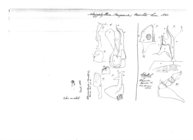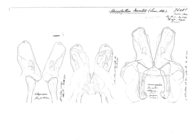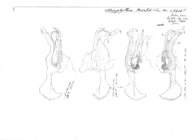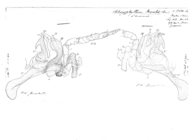MilliBase
MilliBase taxon details
Ommatoiulus moreleti (Lucas, 1860)
394570 (urn:lsid:marinespecies.org:taxname:394570)
accepted
Species
Archiulus moreleti (Lucas, 1860) · unaccepted
Hemipodoiulus karschi (Verhoeff, 1892) · unaccepted
Iulus karschi Verhoeff, 1892 · unaccepted
Iulus moreleti Lucas, 1860 · unaccepted
Julus karschi Verhoeff, 1892 · unaccepted
Julus lusitanicus Karsch, 1881 · unaccepted
Julus moreleti Lucas, 1860 · unaccepted (basionym)
Ommatoiulus cervinus (Verhoeff, 1910) · unaccepted
Ommatoiulus karschi (Verhoeff, 1892) · unaccepted
Ommatoiulus moreletii (Lucas, 1860) · unaccepted
Palaioiulus karschi (Verhoeff, 1892) · unaccepted
Schizophyllum cervinum Verhoeff, 1910 · unaccepted
Schizophyllum karschi (Verhoeff, 1892) · unaccepted
Schizophyllum moreleti (Lucas, 1860) · unaccepted
(of Iulus moreleti Lucas, 1860) Lucas, H. (1860). Myriapodes. In: Morelet, A. Notice sur l'Histoire Naturelle des Açores, suivie d'une description des Mollusques terrestres de cet Archipel. Paris : J.-B. Baillière et Fils 216 pp., 96-97
page(s): 96 [details]
page(s): 96 [details]
Type locality contained in Azores
type locality contained in Azores [from synonym] [view taxon] [details]
Distribution Originating in Iberian peninsula. Accidentally introduced to Australia (including Tasmania) where it has become a pest species.
Distribution Originating in Iberian peninsula. Accidentally introduced to Australia (including Tasmania) where it has become a pest species. [details]
MilliBase (2024). Ommatoiulus moreleti (Lucas, 1860). Accessed at: https://www.millibase.org/aphia.php?p=taxdetails&id=394570 on 2024-12-22
Date
action
by
original description
(of Schizophyllum cervinum Verhoeff, 1910) Verhoeff, K. W. (1910). Über Diplopoden. 11.-15. (31.-35.) Aufsatz: Beiträge zur Kenntnis der Glomeriden, Juliden, Ascospermorpha und Lysiopetaliden, sowie zur Fauna Siziliens, Untersuchungen über Art- und Gruppensystematik, Morphologie, nachembryonale Entwicklung, Biologie und Geographie. <em>Nova acta Academiae Caesareae Leopoldino-Carolinae Germanicae Naturae Curiosorum. Abhandlungen der Kasiserl. Leop.-Carol. Deutschen Akademie der Naturforscher.</em> 92(2): 139-448. Halle a. S., available online at https://www.biodiversitylibrary.org/page/41060865
page(s): 200 [details]
original description (of Julus karschi Verhoeff, 1892) Verhoeff, K. W. (1892). Neue Diplopoden der paläarktischen Region. Zoologischer Anzeiger, 15(403): 377-387. Leipzig
page(s): 380 [details]
original description (of Iulus moreleti Lucas, 1860) Lucas, H. (1860). Myriapodes. In: Morelet, A. Notice sur l'Histoire Naturelle des Açores, suivie d'une description des Mollusques terrestres de cet Archipel. Paris : J.-B. Baillière et Fils 216 pp., 96-97
page(s): 96 [details]
context source (Bermuda) Chamberlin, R. V. (1920). The myriopod fauna of the Bermuda Islands, with notes on the variation in Scutigera. Annals of the Entomological Society of America, 13(3): 271-302. Columbus [details]
basis of record Barber, A. D. (2009). Littoral myriapods. a review. <em>Soil Organisms.</em> 81(3): 735-760., available online at https://www.senckenberg.de/wp-content/uploads/2019/08/33_barber.pdf [details] Available for editors
additional source Kime, R. D.; Enghoff, H. (2017). Atlas of European millipedes 2: Order Julida (Class Diplopoda). <em>European Journal of Taxonomy.</em> 346: 1–299., available online at https://doi.org/10.5852/ejt.2017.346
page(s): 140 [details]
additional source Akkari, N.; Enghoff, H. (2017). Revision of the genus Ommatoiulus Latzel, 1884 (Julida, Diplopoda) in Portugal, with description of six new species. <em>European Journal of Taxonomy.</em> 295: 1-42., available online at https://doi.org/10.5852/ejt.2017.295
page(s): 22-24, Fig. 16 [details]
additional source Akkari, N.; Gilgado, J. D.; Ortuño, V. M.; Enghoff, H. (2018). Out of the dark void: Ommatoiulus longicornis n. sp., a new julid from Spain (Diplopoda, Julida) with notes on some troglobiomorphic traits in millipedes. <em>Zootaxa.</em> 4420(3): 415-429., available online at https://doi.org/10.11646/zootaxa.4420.3.7
page(s): table 2 [details]
page(s): 200 [details]
original description (of Julus karschi Verhoeff, 1892) Verhoeff, K. W. (1892). Neue Diplopoden der paläarktischen Region. Zoologischer Anzeiger, 15(403): 377-387. Leipzig
page(s): 380 [details]
original description (of Iulus moreleti Lucas, 1860) Lucas, H. (1860). Myriapodes. In: Morelet, A. Notice sur l'Histoire Naturelle des Açores, suivie d'une description des Mollusques terrestres de cet Archipel. Paris : J.-B. Baillière et Fils 216 pp., 96-97
page(s): 96 [details]
context source (Bermuda) Chamberlin, R. V. (1920). The myriopod fauna of the Bermuda Islands, with notes on the variation in Scutigera. Annals of the Entomological Society of America, 13(3): 271-302. Columbus [details]
basis of record Barber, A. D. (2009). Littoral myriapods. a review. <em>Soil Organisms.</em> 81(3): 735-760., available online at https://www.senckenberg.de/wp-content/uploads/2019/08/33_barber.pdf [details] Available for editors
additional source Kime, R. D.; Enghoff, H. (2017). Atlas of European millipedes 2: Order Julida (Class Diplopoda). <em>European Journal of Taxonomy.</em> 346: 1–299., available online at https://doi.org/10.5852/ejt.2017.346
page(s): 140 [details]
additional source Akkari, N.; Enghoff, H. (2017). Revision of the genus Ommatoiulus Latzel, 1884 (Julida, Diplopoda) in Portugal, with description of six new species. <em>European Journal of Taxonomy.</em> 295: 1-42., available online at https://doi.org/10.5852/ejt.2017.295
page(s): 22-24, Fig. 16 [details]
additional source Akkari, N.; Gilgado, J. D.; Ortuño, V. M.; Enghoff, H. (2018). Out of the dark void: Ommatoiulus longicornis n. sp., a new julid from Spain (Diplopoda, Julida) with notes on some troglobiomorphic traits in millipedes. <em>Zootaxa.</em> 4420(3): 415-429., available online at https://doi.org/10.11646/zootaxa.4420.3.7
page(s): table 2 [details]
 Present
Present  Inaccurate
Inaccurate  Introduced: alien
Introduced: alien  Containing type locality
Containing type locality
From editor or global species database
Distribution Originating in Iberian peninsula. Accidentally introduced to Australia (including Tasmania) where it has become a pest species. [details]Ecology Seen in large numbers walking over intertidal sand in NW Tasmania in 2007 (Mesibov, pers.comm.) [details]
Habitat This species is either supralittoral or can be found in the intertidal zone but does not live there naturally [details]
| Language | Name | |
|---|---|---|
| English | Portuguese black millipede | [details] |
To Barcode of Life (10 barcodes)
To Biodiversity Heritage Library (2 publications)
To European Nucleotide Archive, ENA (Ommatoiulus moreleti)
To GenBank (3 nucleotides; 1 proteins) (from synonym Julus moreleti Lucas, 1860)
To GenBank (3 nucleotides; 1 proteins) (from synonym Ommatoiulus moreletii (Lucas, 1860))
To GenBank (3 nucleotides; 1 proteins)
To NHMUK collection (Ommatoiulus moreleti (Lucas, 1860); NON-TYPE; NHMUK:ecatalogue:9528671)
To Biodiversity Heritage Library (2 publications)
To European Nucleotide Archive, ENA (Ommatoiulus moreleti)
To GenBank (3 nucleotides; 1 proteins) (from synonym Julus moreleti Lucas, 1860)
To GenBank (3 nucleotides; 1 proteins) (from synonym Ommatoiulus moreletii (Lucas, 1860))
To GenBank (3 nucleotides; 1 proteins)
To NHMUK collection (Ommatoiulus moreleti (Lucas, 1860); NON-TYPE; NHMUK:ecatalogue:9528671)
From editor or global species database










